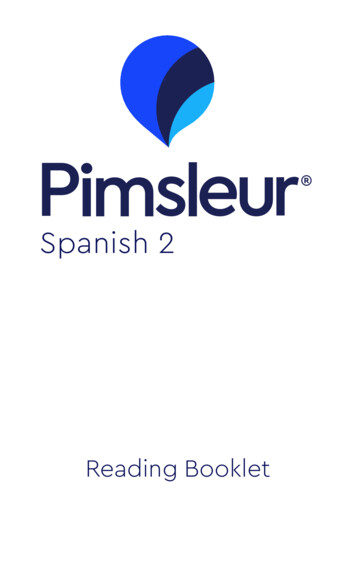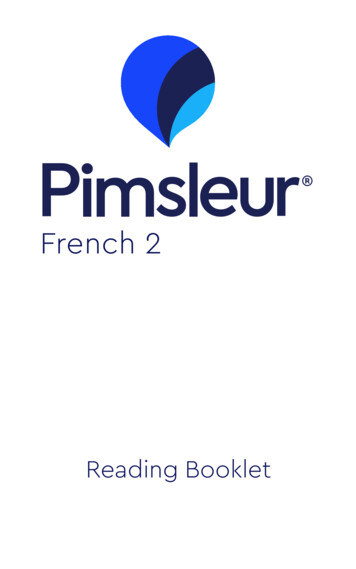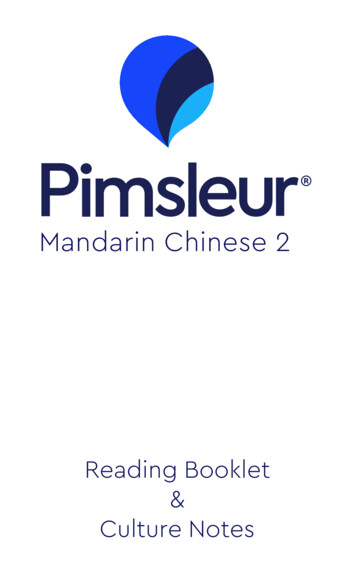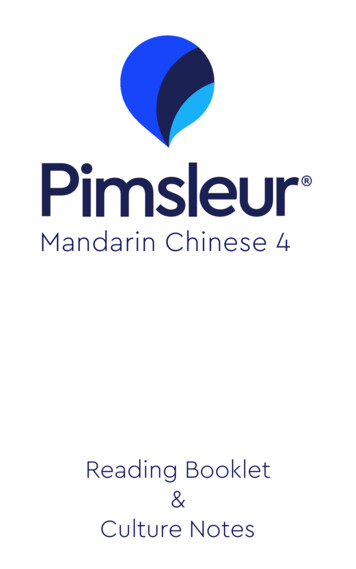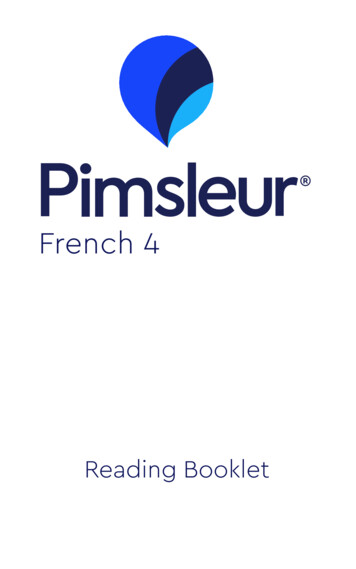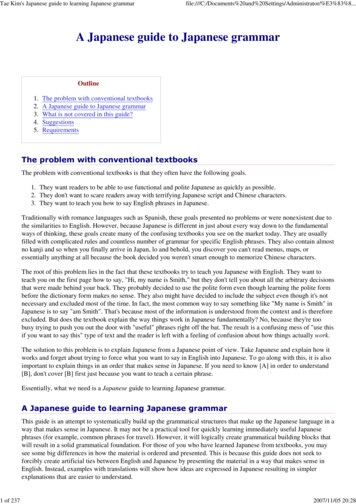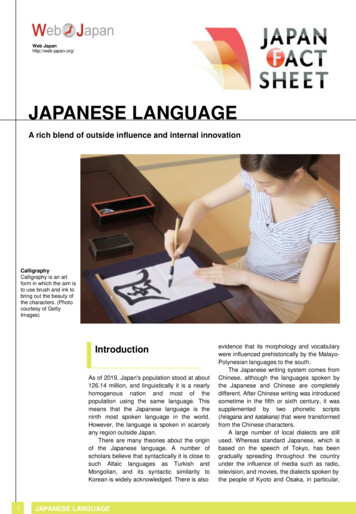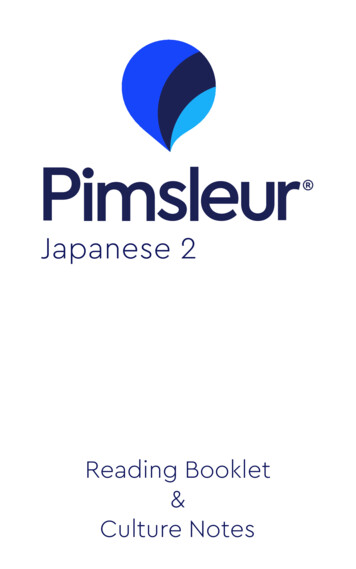
Transcription
Japanese 2Reading Booklet&Culture Notes
Japanese 2Travelers should always check withtheir nation's State Department forcurrent advisories on local conditionsbefore traveling abroad.Second EditionBooklet Design: Maia Kennedy and ‰ Recorded Program 2004 Simon & Schuster, Inc. Reading Booklet 2016 Simon & Schuster, Inc.Pimsleur is an imprint of Simon & Schuster Audio,a division of Simon & Schuster, Inc. Mfg. in USA.All rights reserved.ii
Japanese 2ACKNOWLEDGMENTSVoicesEnglish-Speaking Instructor. Ray BrownJapanese-Speaking Instructor. Tsunenori “Lee” AbeFemale Japanese Speaker. Kimiko Ise AbramoffMale Japanese Speaker. Tsunenori “Lee” AbeCourse WritersKimiko Ise Abramoff Beverly D. HeinleKatakana Readings WritersKimiko Ise Abramoff Shannon RossiNotes AuthorDr. Akira MiyaharaEditorMary E. GreenReviewerMiho HirohashiProducer & DirectorSarah H. McInnisRecording EngineersPeter S. Turpin Kelly SauxSimon & Schuster Studios, Concord, MAiii
Japanese 2Table of ContentsIntroduction. 1Lesson One . 7Lesson Two . 8Lesson Three . 9Lesson Four . 10Lesson Five . 11Lesson Six . 12Lesson Seven . 13Lesson Eight . 14Lesson Nine . 15Lesson Ten . 16Lesson Eleven . 17Lesson Twelve . 18Lesson Thirteen . 19Lesson Fourteen . 20Lesson Fifteen . 21Lesson Sixteen . 22Lesson Seventeen . 23Lesson Eighteen . 24Lesson Nineteen . 25Lesson Twenty . 26iv
Japanese 2IntroductionThe Japanese language has three distinctivewriting systems: kanji, hiragana, and katakana.KanjiIn early Japan, Japanese was a spoken languageonly and there was no writing system. China,however, had already developed a sophisticatedwriting system based on symbols called hanzi.As early as the first century, Japanese people hadsome exposure to these Chinese symbols on coins,official seals, and other decorative items importedfrom China. Like many other Asian countries,Japan adopted the Chinese writing system andby the 5th century, Chinese characters began tobe used earnestly in Japan. The Japanese calledthis writing system kanji, which literally means“Chinese characters.”This new writing system created a new literacyfor the Japanese. When the Japanese adopted theChinese writing system, they used the characters torepresent both meaning as well as sound. As a result,in Japan there are two ways to “read” or pronouncea single Chinese character:· on yomi, based on the original Chinesepronunciation,· kun yomi, native Japanese pronunciation.
Japanese 2Many kanji have multiple pronunciations in bothon yomi and kun yomi.How many kanji are there? That depends onvarious sources. One of the most 00characters, but only an estimated 7,000 are said tobe in daily use. Today in Japan, a kanji dictionarycontains approximately 50,000 characters of which2,100 to 2,200 characters are commonly used.HiraganaSome Japanese sounds and meanings weredifficult to represent using kanji. To fill this gap,kana symbols were invented, based on the soundand the shape of the kanji. One such phoneticsystem is hiragana, which was invented betweenthe eighth and the tenth centuries. Unlike kanji,hiragana represent a sound and not meaning.Hiragana is derived from a cursive form of kanji andthe letters are curvilinear in style. They are used toexpress Japanese grammatical elements such asparticles and the endings of adjectives and verbs.There are forty-six basic hiragana syllables. Thereare also twenty-five additional modified syllables,thirty-six modified /contracted syllables, and onethat is used to transcribe double consonants.2
Japanese 2KatakanaKatakana came into existence at aboutthe same time as hiragana. The shapes of thekatakana letters were also formed based on thekanji, but katakana have straighter lines, whilehiragana are curvier.Today katakana is used mainly to write loanwords which the original Japanese language didnot have. An example is the word for “coffee,” sincecoffee didn’t exist in Japan until it was importedfrom abroad. Katakana is also used for representingonomatopeia, the names of plants and animals (withsome exceptions), and for placing emphasis oncertain words.There are the same number of syllables in bothkatakana and hiragana.3
Japanese 2Reading KanaHiragana and katakana are phoneticallyconsistent, and reading them is relatively straightforward once the letters and their sounds are learned.When writing Japanese today, the three writingsystems are combined — kanji, hiragana, andkatakana can all appear within a single sentence.Here’s an example:デパート に 行きます。(I) go to a department store. (depaato ni ikimasu.)デパートdepartment store (katakana)にpost-positional word to show direction (hiragana)行the root of the verb “go” (kanji)きますending of the verb “go” (hiragana)4
Japanese 2In Level 1, you were introduced to readinghiragana. In this course, you will learn how to readkatakana. For practice, all the words and sentencesin the Reading Lessons are written in katakana.Spaces have been added in the longer phrases forease in reading.Katakana �モヨロ
Japanese 2Katakana Combinations – youonwi / uiキャgya ギャウィkyaウイkyu キュgyu ギュshuシュキョgyo ギョshoショwi / ��ャpyuピュpyoピョmya ミャmyuミュmyo ��ォヴォvatue/fiviフィ fu/hu フッヴィ vuヴfeveフェヴェvoトゥエtweーッ・ tle tsudottwo dashessmall circle6
Japanese 2Lesson .20.スミスミスニミニキスキーミス / �スタミスターミスター・スミス7
Japanese 2Lesson .20.ク/ タテ/ ニラ/ スキ/ ��ム/マミニマムクリスマス8
Japanese 2Lesson ースソックスアン9
Japanese 2Lesson 9.20.ソ/ ンツ/ シコオオンタリオキッチンローン10
Japanese 2Lesson トヤ/ �ラダ11
Japanese 2Lesson フリーダム12
Japanese 2Lesson �ニカピンポンリモコン13
Japanese 2Lesson ��ニカラグア14
Japanese 2Lesson 9.20.ク/ �ブブーツブダペストフ/ プ / ブパパンパンダパプリカ15
Japanese 2Lesson �ケ/ �ンズズッキーニキ/ ヤキャカ / キャキャンプ16
Japanese 2Lesson ��17
Japanese 2Lesson .19.20.キュ / ギュシャ/ �ーヨーク18
Japanese 2Lesson 18.19.20.チャ / チュ / チョジャ / ジュ / ジョニョシャカニョライニャ / ニュ / ピューリタンヒョヒョウタン19
Japanese 2Lesson 18.19.20.ヒャ / ヒュ / ヒョヒャ / ビャ / クリョリョービミャ / ミュ / ミョピャ / ピュ / ピョ20
Japanese 2Lesson �ォリュームサーヴサーブ21
Japanese 2Lesson 8.19.20.ファ / フィ / フェ / フォヴァ/ ヴィ / ヴ / ヴェ / ヴォフィンランド / ヴィクトリアフォーク / �ウエイ / ヴェンダーベンダー / ヴェンダービクトリア/ チェルソフィーアリソン22
Japanese 2Lesson �ヴィル23
Japanese 2Lesson ード・オブ・ザ・リング24
Japanese 2Lesson ��アウシュヴィッツオール ザ ライト ウィ キャン ノット ンソンエンパイア ��ウト25
Japanese 2Lesson ��レーライス26
Japanese 2Culture Notes
Japanese 2Travelers should always check withtheir nation's State Department forcurrent advisories on local conditionsbefore traveling abroad.Booklet Design: Maia KennedySecond Edition and ‰ Recorded Program 2004 Simon & Schuster, Inc. Culture Notes 2010 Simon & Schuster, Inc.Pimsleur is an imprint of Simon & Schuster Audio,a division of Simon & Schuster, Inc. Mfg. in USA.All rights reserved.ii
Japanese 2ACKNOWLEDGMENTSVoicesEnglish-Speaking Instructor. Ray BrownMale Japanese Speaker. Tsunenori “Lee” AbeCourse WritersKimiko Ise Abramoff Beverly D. HeinleEditorMary E. GreenNotes on Japanese Culture & CommunicationDr. Akira MiyaharaProfessor of Communication StudiesSeinan Gakuin UniversityReviewerMiho HirohashiProducer & DirectorSarah H. McInnisRecording EngineerPeter S. Turpin Kelly SauxSimon & Schuster Studios, Concord, MAiii
Japanese 2Table of ContentsNotes on Japanese Culture and Communication . . 1Dialects in Japan . . . . . . . . . . . . . . . . . . . . . . . . . . . . 2Introductions . . . . . . . . . . . . . . . . . . . . . . . . . . . . . . . 3honne and tatemae . . . . . . . . . . . . . . . . . . . . . . . . . 4ocha wa doo desu ka? . . . . . . . . . . . . . . . . . . . . . . 5uchi vs. soto . . . . . . . . . . . . . . . . . . . . . . . . . . . . . . . 6Bus Transportation in Japan . . . . . . . . . . . . . . . . . . . 7nanika nomitai n desu ga. . . . . . . . . . . . . . . . . . . . . 7Days of the Week . . . . . . . . . . . . . . . . . . . . . . . . . . . 8Incomplete Sentences . . . . . . . . . . . . . . . . . . . . . . . 9Politeness: imasu ka? vs. irasshaimasu ka? . . . . . . 10Traveling in and Around Japan . . . . . . . . . . . . . . . . . 11ii desu ne . . . . . . . . . . . . . . . . . . . . . . . . . . . . . . . . . . 12tsumetai and samui. . . . . . . . . . . . . . . . . . . . . . . . . . 12Newspapers in Japan. . . . . . . . . . . . . . . . . . . . . . . . . 13Climate in Japan . . . . . . . . . . . . . . . . . . . . . . . . . . . . . 14musume and musuko . . . . . . . . . . . . . . . . . . . . . . . . 15gochisoosama deshita . . . . . . . . . . . . . . . . . . . . . . 15kuruma and Driving in Japan . . . . . . . . . . . . . . . . . . 16Emergency Calls . . . . . . . . . . . . . . . . . . . . . . . . . . . . 17Drugstores and Convenience Stores . . . . . . . . . . . . 17Trains in Japan . . . . . . . . . . . . . . . . . . . . . . . . . . . . . . 18Playing Sports in Japan . . . . . . . . . . . . . . . . . . . . . . . 19zuibun isogashii n desu ne . . . . . . . . . . . . . . . . . . . . 20iv
Japanese 2National Holidays in Japan . . . . . . . . . . . . . . . . . . . .kedo . . . . . . . . . . . . . . . . . . . . . . . . . . . . . . . . . . . . . .Japanese Sweets . . . . . . . . . . . . . . . . . . . . . . . . . . . .Geography of Japan . . . . . . . . . . . . . . . . . . . . . . . . .jaa, mata itsuka . . . . . . . . . . . . . . . . . . . . . . . . . . . .osokunatte sumimasen . . . . . . . . . . . . . . . . . . . . . . .Gift Giving . . . . . . . . . . . . . . . . . . . . . . . . . . . . . . . . .shitsurei shimasu . . . . . . . . . . . . . . . . . . . . . . . . . . . .Continuing Success . . . . . . . . . . . . . . . . . . . . . . . . . .v212223242525262727
Japanese 2Notes on Japanese Culture and CommunicationThese are the Culture Notes for Pimsleur’sJapanese 2. The objective of Japanese 2 is tointroduce you to the language and c
Pimsleur is an imprint of Simon & Schuster Audio, . Japanese people had some exposure to these Chinese symbols on coins, official seals, and other decorative items imported from China. Like many other Asian countries, Japan adopted the Chinese writing system and by the 5th century, Chinese characters began to be used earnestly in Japan. The Japanese called this writing system . kanji .
